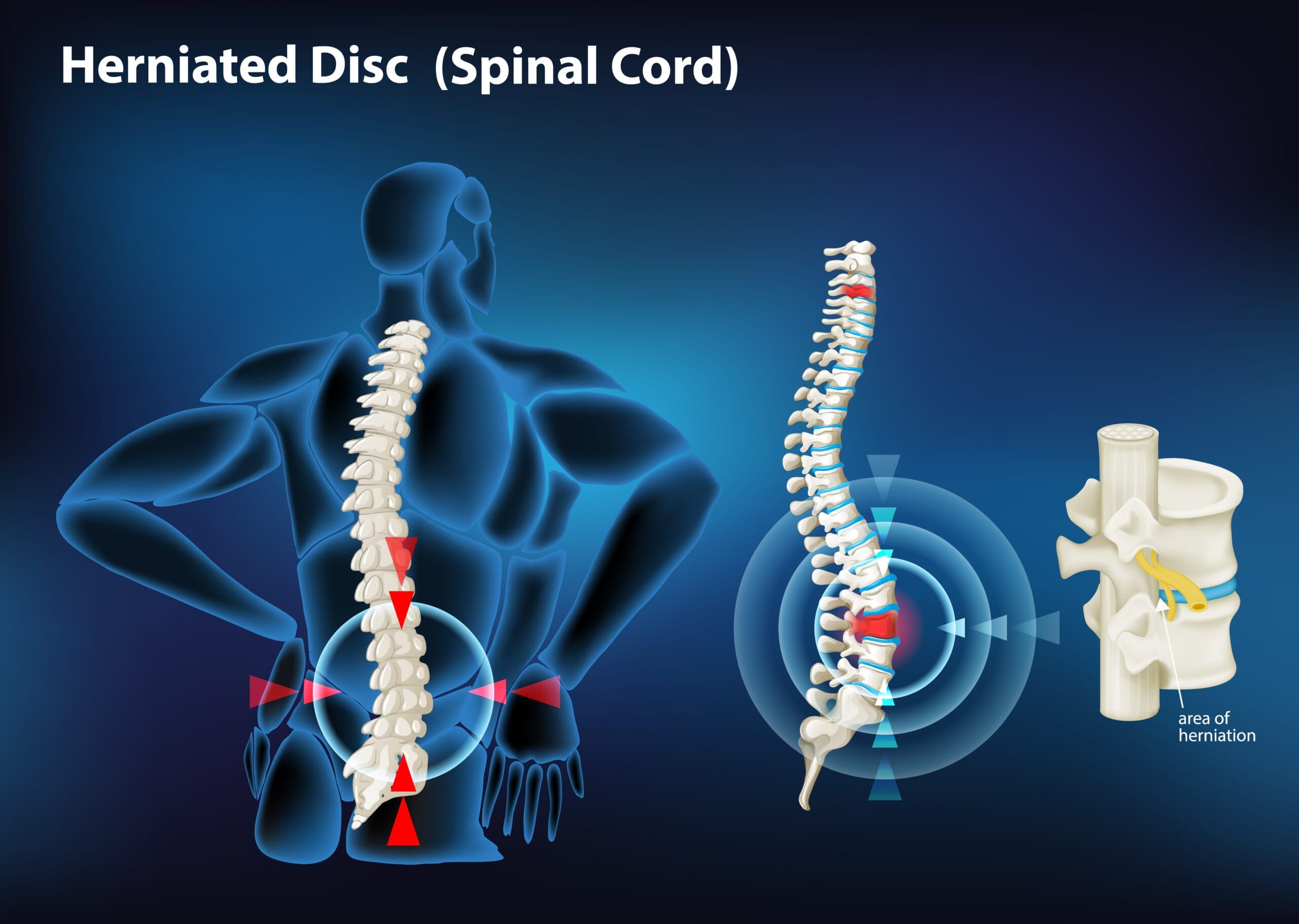Back pain is a common issue that affects millions of people around the world. Among the many reasons for back pain, Prolapsed Intervertebral Disc (PIVD) is one of the most common causes. This condition can be very painful and can make it hard for people to carry out their daily activities. In this article, we will discuss PIVD symptoms, how to identify them, and the steps you can take to manage and treat back pain caused by this condition.
What is PIVD?
Prolapsed Intervertebral Disc (PIVD) happens when the soft, jelly-like center of a spinal disc pushes out through a crack in its tough outer layer. This condition is often called a slipped disc or herniated disc. When this happens, the bulging part of the disc can press on nearby nerves in the spine, leading to pain and other problems. PIVD symptoms can vary widely, depending on the location and severity of the disc injury.
How Does PIVD Occur?
Our spine is made up of bones called vertebrae, and between these bones are small, cushion-like discs. These discs act as shock absorbers, helping us move and bend without pain. Over time, these discs can weaken due to age, injuries, or repeated strain. When the outer layer of a disc tears or wears down, the inner part can bulge out, causing PIVD. Understanding PIVD symptoms can help identify the condition early and seek timely treatment.
Who is at Risk?

PIVD can happen to anyone, but certain factors increase the risk:
- Age: People aged 30 to 50 are more likely to develop PIVD because of natural wear and tear on the spine.
- Heavy Lifting: Jobs or activities that involve lifting heavy objects can strain the spine.
- Prolonged Sitting: Sitting for a long period of time, especially with poor posture, puts pressure on the discs.
- Obesity: Extra body weight increases stress and weight on the spine.
- Smoking: Smoking reduces blood flow to the discs, making them weaker over time.
- Injuries: Accidents or sudden movements can cause a disc to slip.
- Genetics: Some people may inherit weaker spinal structures, making them more prone to PIVD.
Common PIVD Symptoms
Recognizing the symptoms early is very important. Symptoms can differ according to the location of the damaged disc and the severity of the condition. Below are the most common signs:
1. Back Pain
The most common symptom of PIVD is pain in the lower back. This pain can be slight or severe and might worsen when you move, bend or sit for a long time. For example, someone with PIVD might feel a sharp pain when bending to pick up something from the floor.
2. Pain That Spreads to Other Areas
If the slipped disc presses on the sciatic nerve, it can cause pain that radiates from the lower back to the buttocks, thighs and even the feet. This is called sciatica. The pain may feel like a burning or shooting sensation. This is one of the classic PIVD symptoms that patients report.
3. Numbness or Tingling
Another common symptom of PIVD is numbness or a tingling feeling in the legs, feet, or arms. This happens because the bulging disc irritates the nearby nerves, disrupting their normal function. Numbness is one of the PIVD symptoms that can interfere with daily activities.
4. Weak Muscles
PIVD can weaken the muscles in the affected area. For instance, if the disc affects nerves connected to the legs, a person might find it hard to lift their foot or stand on their toes. This weakness can make walking or performing simple tasks difficult.
5. Bladder or Bowel Problems
In rare but serious cases, PIVD can press on nerves that control the bladder or bowels. This can lead to problems like losing control over urination or bowel movements. If this happens, it is a medical emergency, and you should see a doctor immediately.
How is PIVD Diagnosed?

If you think you have PIVD symptoms, it is important to visit a doctor. They will do a thorough check-up, which may include:
- Physical Exam: The doctor will evaluate your reflexes, muscle strength and ability to move.
- Imaging Tests: An MRI (Magnetic Resonance Imaging) or CT (Computed Tomography) scan can show detailed pictures of your spine and help confirm the diagnosis.
- Nerve Tests: Tests like electromyography (EMG) can check how well your nerves are working.
How to Manage Back Pain Caused by PIVD
The good news is that most cases of PIVD improve without surgery. Below are some of the best ways to manage back pain caused by PIVD:
1. Rest and Modify Activities
If your back pain is severe, take short breaks to rest. Avoid staying in bed for too long as this can make the problem worse. Instead, try to move around gently and avoid activities that cause pain like heavy lifting or bending. Adjusting your daily routine can help reduce PIVD symptoms.
2. Use Pain Relief Methods
- Medications: Over the counter pain relievers like ibuprofen or acetaminophen can reduce pain and swelling. If the pain increases, your doctor may prescribe stronger medicines.
- Heat and Ice Packs: Applying a heat pack can relax tight muscles, while an ice pack can reduce swelling and numb the pain. These methods may provide temporary relief from the symptoms.
3. Physical Therapy
A physical therapist will teach you particular exercises to strengthen your back and core muscles. For example:
- Stretching Exercises: These can improve flexibility and reduce pressure on the spine.
- Strengthening Exercises: These help support the spine and prevent future injuries. For instance, exercises like bridges and planks are effective.
- Posture Training: Learning how to sit, stand and lift properly can reduce strain on your back. Physiotherapy plays a key role in managing these symptoms.
4. Lifestyle Changes
Making a simple changes in your daily routine can go a long way in managing PIVD symptoms:
- Stay Active: Regular low-impact exercises like walking, swimming, or yoga can improve your spine health.
- Maintain a Healthy Weight: Losing excess weight reduces the load on your spine.
- Use Proper Posture: Sit with your back straight and shoulders relaxed. If you work at a desk, use a chair with good lumbar support.
- Quit Smoking: Stopping smoking can improve blood flow to the spine and speed up healing.
Incorporating healthy habits can aid in recovery and overall well being. For tips on enhancing your health consider reading Simple Ways to Boost Immune System Naturally.
5. Alternative Therapies
Some people find relief from PIVD symptoms through alternative treatments such as:
- Chiropractic Care: A chiropractor can perform gentle adjustments to improve spine alignment.
- Acupuncture: This technique uses thin needles to decrease pain and improve overall well being.
- Massage Therapy: Massage will help relax tight muscles and increase blood flow to the affected area.
6. Surgery
If non-surgical treatments do not help, or if PIVD causes severe nerve problems, surgery may be needed. Common surgical options include:
- Discectomy: Removing the part of the disc that is pressing on the nerve.
- Laminectomy: Creating more space around the spinal nerves by removing a small part of the bone.
- Spinal Fusion: Joining two or more vertebrae together to stabilize the spine.
After surgery, physiotherapy and rehabilitation are important for a successful recovery. Surgery is usually a last option for managing PIVD symptoms.
Preventing PIVD
While you cannot always prevent PIVD, you can reduce your risk by following these tips:
- Exercise Regularly: Focus on exercises which can strengthen your back and core muscles.
- Lift Safely: Always bend your knees and keep your back straight when lifting heavy objects.
- Choose Ergonomic Furniture: Use a supportive chair and desk setup, especially if you sit for long hours.
- Stay Active: Avoid sitting for too long by taking breaks to stretch and walk around. Preventive measures can significantly lower your chances of developing PIVD symptoms.
When to Seek Medical Help
You should see a doctor if:
- Your back pain does not improve with rest and home treatments.
- You experience numbness, tingling or weakness in your arms or legs.
- You have problem with walking or maintaining your balance.
- You lose control of your bladder or bowels.
Conclusion
PIVD symptoms can be painful and disruptive, but with the correct approach, they can be managed effectively. By recognizing the signs early, seeking proper medical care, and making healthy lifestyle changes, you can reduce back pain and enhance your quality of life. If you suspect you have these symptoms, do not hesitate to contact an orthopedic specialist. Remember, early intervention is key to preventing complications and living a pain-free life.
Frequently Asked Questions
1. What are the early symptoms of PIVD to watch for?
Early PIVD symptoms include mild back pain, stiffness, or discomfort that may worsen with movement. Some people also experience tingling or numbness in the legs.
2. Can symptoms of PIVD go away on their own?
In many cases, mild PIVD symptoms can improve with rest, physical therapy, and lifestyle changes. However, severe symptoms may require medical treatment or surgery.
3. How is PIVD diagnosed?
PIVD is diagnosed through physical exams, imaging tests like MRI or CT scans, and sometimes nerve tests to check how well the nerves are functioning.
4. What is the best treatment for managing symptoms of PIVD?
Treatments include rest, medications, physical therapy, exercises, and lifestyle changes. Severe cases may need surgery, but most people recover without it.
5. Can symptoms of PIVD be prevented?
While not all cases can be prevented, you can reduce your risk by maintaining a healthy weight, exercising regularly, practicing good posture, and avoiding heavy lifting or prolonged sitting.
Images By: FreePik




